MaryAnn Bernal's Blog, page 222
November 3, 2014
Pebble In The Still Waters: Author Interview: Mary Ann Bernal: Scribbler Tales...
Pebble In The Still Waters: Author Interview: Mary Ann Bernal: Scribbler Tales...: Mary Ann Bernal, author of The Briton and the Dane novels, is an avid history buff whose area of interest focuses on Ninth Century Angl...
Monday, November 03, 2014 Mary Ann Bernal, author of The Briton and the Dane novels, is an avid history buff whose area of interest focuses on Ninth Century Anglo-Saxon Britain during the Viking Age. While pursuing a degree in business administration, she managed to fit creative writing classes and workshops into her busy schedule to learn the craft, but it would take decades before her “Erik the Viking” novel was ultimately published.
Mary Ann is also a passionate supporter of the United States military, having been involved with letter writing campaigns and other support programs since Operation Desert Storm. She has appeared on The Morning Blend television show hosted by KMTV, the CBS television affiliate in Omaha, and was interviewed by the Omaha World-Herald for her volunteer work. She has also been a featured author on Triangle Variety Radio, The Phil Naessens Show, and The Writers Showcase, and has been interviewed extensively by American and European bloggers.
Mary Ann currently resides in Omaha, Nebraska.
Your real name and pen name?
Mary Ann Bernal. I do not use a pen name.

Please share some of the best memories of your childhood
Friday nights were pizza night for our family. We would walk (yes, walk; dad said we needed the exercise) thirty minutes to Frank & Joe’s Pizzeria where we ordered a large cheese pizza, waiting in anticipation for the gooey melted cheese that dripped off the slice. Sunday afternoons found us at Carvel, indulging our sweet tooth by devouring soft ice cream cones - vanilla was my favorite. Speaking of sweet tooth, imagine the excitement when the local bakery began making Napoleon birthday cakes - conventional cakes no longer had a place in our family celebrations.

About your education
Since my initial career path was to work in the medical field, I graduated from Mandl School located in New York City and worked in a local hospital until the birth of my son. Switching careers, I graduated from Elisabeth Seton College located in Yonkers, NY with an Associate Degree and obtained my Bachelor of Science degree at Mercy College located in Dobbs Ferry, NY.
Even though my training was in the medical and business professions, I honed my writing skills by attending creative writing courses and workshops throughout the years. I also completed a novel writing course at Winghill Writing School prior to completing my first novel, The Briton and the Dane.
What languages can you speak and write?
While I studied French for four years in high school, I have not read or spoken the language since graduation.
What is your biggest source of inspiration in life?
Throughout the centuries, there have been famous heroes and heroines whose courage and resolve changed history. Reading about people who never give up, no matter the adversity, is truly inspirational. Social media has increased awareness of issues concerning the human condition, and it is heartwarming to read about the not-so-famous success stories, such as overcoming a disability or surviving cancer.

If you had to live a day of your life as one of the living or dead personality, who would it be and why?
Spending the day as Eleanor of Aquitaine who was one of the most powerful women in the Middle Ages. While Queen Consort of France, she accompanied her husband, King Louis VII, on the Second Crusade. While Queen Dowager of England, she ruled as regent while her son, Richard I, fought in the Third Crusade. I would like to become privy to her thought processes i.e. what factors prompted her decisions and if she had any regrets.
What is your favorite genre and why?
Historical fiction is my favorite. History is my passion, especially ancient civilizations and English history through the Tudor years. My novels reflect my enthusiasm, but my historical references are merely a setting, the meat of the story involves the plight of the characters.

When did you start writing? What is the purpose of your writing?
My love of writing started when I was in high school. My novels have subtle themes that shed light on problems we face today, such as the plight of the military family when a loved one is deployed. Society as a whole tends to take things for granted, such as freedom, which is not free. Stating a modern problem in a long ago age lessens preconceived attitudes and hopefully, alters opinions.

Which of your work has been published so far? Would you like to share a synopsis of your work?
Historical Fiction: The Briton and the Dane trilogy: The Briton and the Dane; The Briton and the Dane: Birthright and The Briton and the Dane: Legacy. The Briton and the Dane: Concordia and The Briton and the Dane: Timeline are offshoot novels.

Contemporary: Scribbler Tales (Volume One) - a collection of short stories.
Excerpt from The Briton and the Dane: Timeline
Prologue
It was a crisp autumn day in the year of our Lord 2066. The sun was obscured by swollen storm clouds as wind gusts scattered leaves across the empty courtyard, scraping tree branches against office windows.
Inside the stone building, oblivious to the impending storm, students went about their daily tasks like automatons, cataloging fragile remnants of antiquated history. Their enthusiasm had been lost over time, vanquished by archaic rules and lack of funding, drowning in an apathetic sea.
The door opened just as a heavy rain began to pummel the earth. Lightning flashed perilously close to the portico, the building shaken by crackling rolls of thunder. Dr. Malcolm Knýtlinga, department head, scoured the room, nodding to his worker drones as he headed towards the stairwell. He ran down the stairs, deeper into the bowels of the ancient edifice, slowing his gait once he reached the basement. Malcolm peered into the open doorways where artifacts were stored, priceless relics forgotten by a society no longer curious about the past.
The lights flickered briefly as the tempest enveloped the city. He walked the length of the corridor and stopped once he reached the last office, knocking on the doorframe before entering.“One minute,” Gwyneth said, her eyes upon the monitor, her nimble fingers flying across the outdated keyboard.While Dr. Franger had mastered every aspect of computer technology available at the present time, she preferred typing her words rather than speaking them aloud. She even had a typewriter that still worked, proudly displayed in her office at home. She was considered eccentric amongst her peers, but the study body praised her for defiance, and her classes were always filled.
Malcolm shook his head as he sat in his favorite chair, his eyes transfixed on the portrait hanging above his protégé’s desk. An alleged likeness of Lord Erik, the last descendant of Gwyneth and Erik of Wareham, painted years after his death by an unknown medieval artist. Legend described a mighty warrior, proficient not only with the sword but with the pen, a man of letters who had served his king well. Songs attesting to Lord Erik’s prowess on the battlefield had even been sung by the troubadours, only to be lost with the passage of time. Yet time simply enhanced the mystique of this Saxon of Danish descent whose untimely death was suspect, implying treachery and betrayal in a violent age.
Malcolm tolerated Gwyneth’s obsession with a man who had died centuries ago, but he was not sure why. Gwyneth and Erik had started the dynasty, and perhaps Dr. Gwyneth Franger was the reincarnation of the first Gwyneth if one believed in reincarnation.“You are doing it again,” Malcolm thought. “Why not just admit you love the woman and be done with it?”
What are your forthcoming writings?
Scribbler Tales (volume two) will be released later this year. Betrayal (short story) is included in The Independent Author Index compilation (Volume 4) to be released in October.Escape from Berlin (short story) is included in The Independent Author Index compilation (Volume 5) to be released later this year.

What are your future plans?
Currently, I am working with producers for the audio version of Scribbler Tales and The Briton and the Dane trilogy.
Audio books of The Briton and the Dane and The Briton and the Dane: Timeline have recently launched and are available on Audible and iTunes.

What is generally your preference in reading – a paper book or ebook? And why?
While I love paperbacks for my library, I prefer eBooks only because they don’t weigh as much, and I can have more than one novel on my device.

What four top most things you take care of while writing a book?
My days are structured since family comes first. Exercising is also important as is getting out and about, especially to attend the grandchildren’s events. However, I have burned the midnight oil when necessary to finish a thought process or chapter.

How much real life goes into fiction writing?
Stories are written based on life events, whether they happened today or centuries ago. As the saying goes, there are only seven original stories. The topic has been said, but it’s the way you spin the tale that makes the story unique.

Is high level of imagination important to have for an Author?
Imagination, curiosity and creativity are important for everyone, not just authors. Without these traits, boredom sets in, which stagnates the world.
Your dream destination on Earth?
Does it have to be Earth? Would love to travel the universe on the Star Ship Enterprise - would be happy to do a five-year mission.

Your origin of birth and other countries you have visited/ stayed. What best things you liked in these countries around the globe?
Visiting the U.K., Ireland, Italy and Greece has been fun and rewarding. While the historical sites are interesting, meeting the people and learning about differing traditions is exciting. I still correspondence with people I met on my trips - it doesn’t get any better than this.

Your zodiac/ sunsign?
Capricorn. Traditional Traits: Practical and prudent; ambitious and disciplined; patient and careful; humorous and reserved.
Your favorite color and why?
Teal. The color combines blue and green, my favorites.

Your favorite book and why?
Ivanhoe by Sir Walter Scott - read by an impressionable teenager, giving rise to the incurable romantic Anglophile adult.
Your favorite movie and why?
Centurion - the period movie is set in Roman Britain. Adds more fuel to my Roman Empire fascination fire.
Your favorite food?
The list is lengthy, but the top three would be: Chinese, Seafood, Italian.
Your favorite sports?
Football (not soccer) and my favorite college team is Navy - GO NAVY - BEAT ARMY

What comes to your mind when you think of India?
The Taj Mahal built by an emperor to memorialize his wife - how romantic is that?
Some quickies: Sun or Moon, Laughter or Smile, Morning or Evening, Coffee or Tea, Mountain or Sea, Long Drive or Short Drive, Silence or Conversation, Water or Fire, Air or Earth, Mars or Jupiter, Tulip or Rose, Red or Blue, Left or Right, Glance or Stare, Fame or Money, Boy or Girl, Day or Night, Tree or Plant, Love or Passion
First thing you do in the morning after waking up?
Have a mug of coffee.
Last thing to do before sleep?
Shut off the TV, lest Poltergeist invades your space!
State your signature line/ tagline/ best quote
Never Give Up, Never Surrender - Galaxy Quest - Jason Nesmith
Relevant links: (four)
Webpage: http://www.maryannbernal.comPublisher: http://www.whisperinglegendspress.com... http://maryannbernal.blogspot.com
Twitter: https://twitter.com/BritonandDane
Monday, November 03, 2014 Mary Ann Bernal, author of The Briton and the Dane novels, is an avid history buff whose area of interest focuses on Ninth Century Anglo-Saxon Britain during the Viking Age. While pursuing a degree in business administration, she managed to fit creative writing classes and workshops into her busy schedule to learn the craft, but it would take decades before her “Erik the Viking” novel was ultimately published.

Mary Ann is also a passionate supporter of the United States military, having been involved with letter writing campaigns and other support programs since Operation Desert Storm. She has appeared on The Morning Blend television show hosted by KMTV, the CBS television affiliate in Omaha, and was interviewed by the Omaha World-Herald for her volunteer work. She has also been a featured author on Triangle Variety Radio, The Phil Naessens Show, and The Writers Showcase, and has been interviewed extensively by American and European bloggers.

Mary Ann currently resides in Omaha, Nebraska.
Your real name and pen name?
Mary Ann Bernal. I do not use a pen name.

Please share some of the best memories of your childhood
Friday nights were pizza night for our family. We would walk (yes, walk; dad said we needed the exercise) thirty minutes to Frank & Joe’s Pizzeria where we ordered a large cheese pizza, waiting in anticipation for the gooey melted cheese that dripped off the slice. Sunday afternoons found us at Carvel, indulging our sweet tooth by devouring soft ice cream cones - vanilla was my favorite. Speaking of sweet tooth, imagine the excitement when the local bakery began making Napoleon birthday cakes - conventional cakes no longer had a place in our family celebrations.

About your education
Since my initial career path was to work in the medical field, I graduated from Mandl School located in New York City and worked in a local hospital until the birth of my son. Switching careers, I graduated from Elisabeth Seton College located in Yonkers, NY with an Associate Degree and obtained my Bachelor of Science degree at Mercy College located in Dobbs Ferry, NY.
Even though my training was in the medical and business professions, I honed my writing skills by attending creative writing courses and workshops throughout the years. I also completed a novel writing course at Winghill Writing School prior to completing my first novel, The Briton and the Dane.

What languages can you speak and write?
While I studied French for four years in high school, I have not read or spoken the language since graduation.
What is your biggest source of inspiration in life?
Throughout the centuries, there have been famous heroes and heroines whose courage and resolve changed history. Reading about people who never give up, no matter the adversity, is truly inspirational. Social media has increased awareness of issues concerning the human condition, and it is heartwarming to read about the not-so-famous success stories, such as overcoming a disability or surviving cancer.

If you had to live a day of your life as one of the living or dead personality, who would it be and why?
Spending the day as Eleanor of Aquitaine who was one of the most powerful women in the Middle Ages. While Queen Consort of France, she accompanied her husband, King Louis VII, on the Second Crusade. While Queen Dowager of England, she ruled as regent while her son, Richard I, fought in the Third Crusade. I would like to become privy to her thought processes i.e. what factors prompted her decisions and if she had any regrets.

What is your favorite genre and why?
Historical fiction is my favorite. History is my passion, especially ancient civilizations and English history through the Tudor years. My novels reflect my enthusiasm, but my historical references are merely a setting, the meat of the story involves the plight of the characters.

When did you start writing? What is the purpose of your writing?
My love of writing started when I was in high school. My novels have subtle themes that shed light on problems we face today, such as the plight of the military family when a loved one is deployed. Society as a whole tends to take things for granted, such as freedom, which is not free. Stating a modern problem in a long ago age lessens preconceived attitudes and hopefully, alters opinions.

Which of your work has been published so far? Would you like to share a synopsis of your work?
Historical Fiction: The Briton and the Dane trilogy: The Briton and the Dane; The Briton and the Dane: Birthright and The Briton and the Dane: Legacy. The Briton and the Dane: Concordia and The Briton and the Dane: Timeline are offshoot novels.

Contemporary: Scribbler Tales (Volume One) - a collection of short stories.
Excerpt from The Briton and the Dane: Timeline
Prologue
It was a crisp autumn day in the year of our Lord 2066. The sun was obscured by swollen storm clouds as wind gusts scattered leaves across the empty courtyard, scraping tree branches against office windows.

Inside the stone building, oblivious to the impending storm, students went about their daily tasks like automatons, cataloging fragile remnants of antiquated history. Their enthusiasm had been lost over time, vanquished by archaic rules and lack of funding, drowning in an apathetic sea.

The door opened just as a heavy rain began to pummel the earth. Lightning flashed perilously close to the portico, the building shaken by crackling rolls of thunder. Dr. Malcolm Knýtlinga, department head, scoured the room, nodding to his worker drones as he headed towards the stairwell. He ran down the stairs, deeper into the bowels of the ancient edifice, slowing his gait once he reached the basement. Malcolm peered into the open doorways where artifacts were stored, priceless relics forgotten by a society no longer curious about the past.

The lights flickered briefly as the tempest enveloped the city. He walked the length of the corridor and stopped once he reached the last office, knocking on the doorframe before entering.“One minute,” Gwyneth said, her eyes upon the monitor, her nimble fingers flying across the outdated keyboard.While Dr. Franger had mastered every aspect of computer technology available at the present time, she preferred typing her words rather than speaking them aloud. She even had a typewriter that still worked, proudly displayed in her office at home. She was considered eccentric amongst her peers, but the study body praised her for defiance, and her classes were always filled.

Malcolm shook his head as he sat in his favorite chair, his eyes transfixed on the portrait hanging above his protégé’s desk. An alleged likeness of Lord Erik, the last descendant of Gwyneth and Erik of Wareham, painted years after his death by an unknown medieval artist. Legend described a mighty warrior, proficient not only with the sword but with the pen, a man of letters who had served his king well. Songs attesting to Lord Erik’s prowess on the battlefield had even been sung by the troubadours, only to be lost with the passage of time. Yet time simply enhanced the mystique of this Saxon of Danish descent whose untimely death was suspect, implying treachery and betrayal in a violent age.

Malcolm tolerated Gwyneth’s obsession with a man who had died centuries ago, but he was not sure why. Gwyneth and Erik had started the dynasty, and perhaps Dr. Gwyneth Franger was the reincarnation of the first Gwyneth if one believed in reincarnation.“You are doing it again,” Malcolm thought. “Why not just admit you love the woman and be done with it?”

What are your forthcoming writings?
Scribbler Tales (volume two) will be released later this year. Betrayal (short story) is included in The Independent Author Index compilation (Volume 4) to be released in October.Escape from Berlin (short story) is included in The Independent Author Index compilation (Volume 5) to be released later this year.

What are your future plans?
Currently, I am working with producers for the audio version of Scribbler Tales and The Briton and the Dane trilogy.
Audio books of The Briton and the Dane and The Briton and the Dane: Timeline have recently launched and are available on Audible and iTunes.

What is generally your preference in reading – a paper book or ebook? And why?
While I love paperbacks for my library, I prefer eBooks only because they don’t weigh as much, and I can have more than one novel on my device.

What four top most things you take care of while writing a book?
My days are structured since family comes first. Exercising is also important as is getting out and about, especially to attend the grandchildren’s events. However, I have burned the midnight oil when necessary to finish a thought process or chapter.

How much real life goes into fiction writing?
Stories are written based on life events, whether they happened today or centuries ago. As the saying goes, there are only seven original stories. The topic has been said, but it’s the way you spin the tale that makes the story unique.

Is high level of imagination important to have for an Author?
Imagination, curiosity and creativity are important for everyone, not just authors. Without these traits, boredom sets in, which stagnates the world.
Your dream destination on Earth?
Does it have to be Earth? Would love to travel the universe on the Star Ship Enterprise - would be happy to do a five-year mission.

Your origin of birth and other countries you have visited/ stayed. What best things you liked in these countries around the globe?
Visiting the U.K., Ireland, Italy and Greece has been fun and rewarding. While the historical sites are interesting, meeting the people and learning about differing traditions is exciting. I still correspondence with people I met on my trips - it doesn’t get any better than this.

Your zodiac/ sunsign?
Capricorn. Traditional Traits: Practical and prudent; ambitious and disciplined; patient and careful; humorous and reserved.
Your favorite color and why?
Teal. The color combines blue and green, my favorites.

Your favorite book and why?
Ivanhoe by Sir Walter Scott - read by an impressionable teenager, giving rise to the incurable romantic Anglophile adult.
Your favorite movie and why?
Centurion - the period movie is set in Roman Britain. Adds more fuel to my Roman Empire fascination fire.
Your favorite food?
The list is lengthy, but the top three would be: Chinese, Seafood, Italian.
Your favorite sports?
Football (not soccer) and my favorite college team is Navy - GO NAVY - BEAT ARMY

What comes to your mind when you think of India?
The Taj Mahal built by an emperor to memorialize his wife - how romantic is that?
Some quickies: Sun or Moon, Laughter or Smile, Morning or Evening, Coffee or Tea, Mountain or Sea, Long Drive or Short Drive, Silence or Conversation, Water or Fire, Air or Earth, Mars or Jupiter, Tulip or Rose, Red or Blue, Left or Right, Glance or Stare, Fame or Money, Boy or Girl, Day or Night, Tree or Plant, Love or Passion
First thing you do in the morning after waking up?
Have a mug of coffee.
Last thing to do before sleep?
Shut off the TV, lest Poltergeist invades your space!
State your signature line/ tagline/ best quote
Never Give Up, Never Surrender - Galaxy Quest - Jason Nesmith
Relevant links: (four)
Webpage: http://www.maryannbernal.comPublisher: http://www.whisperinglegendspress.com... http://maryannbernal.blogspot.com
Twitter: https://twitter.com/BritonandDane

Published on November 03, 2014 11:35
History Trivia - Parliament accepts the Act of Supremacy: Henry VIII is head of the Church of England
November 3
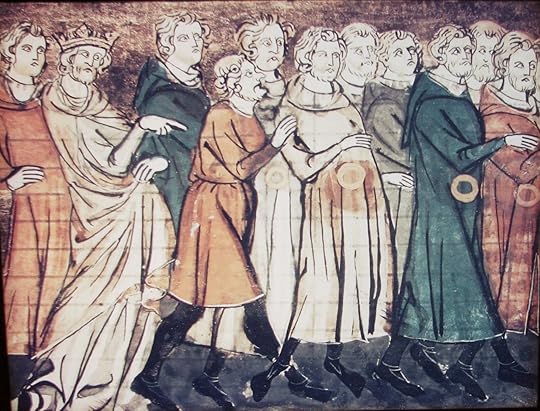
1394 Jews were expelled from France by Charles VI.
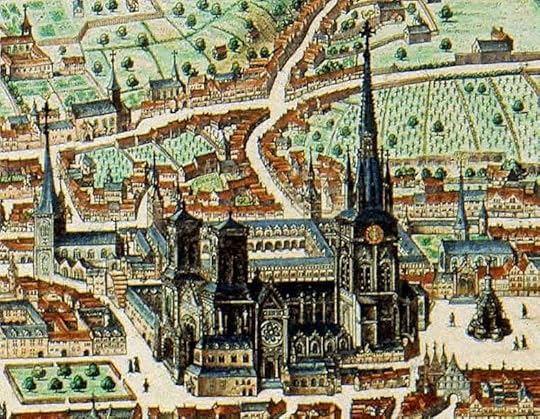
1468 Liège was sacked by Charles I of Burgundy's troops.

1470 Edward V, King of England was born.

1507 Leonardo da Vinci was commissioned to paint the Mona Lisa.

1529 London - first sitting of the Reformation Parliament.

1534 English Parliament accepts the Act of Supremacy: Henry VIII is head of the Church of England.


1394 Jews were expelled from France by Charles VI.

1468 Liège was sacked by Charles I of Burgundy's troops.

1470 Edward V, King of England was born.

1507 Leonardo da Vinci was commissioned to paint the Mona Lisa.

1529 London - first sitting of the Reformation Parliament.

1534 English Parliament accepts the Act of Supremacy: Henry VIII is head of the Church of England.

Published on November 03, 2014 04:55
November 2, 2014
Mr. Chuckles bumps into the charming English gentleman, Geoffrey West, around the Wizard's Cauldron

The Wizard says:
Everyone connected with The Wizard's Cauldron is a big fan of Geoffrey West. A classy, polite and charming English gentleman living near the dreaming spires of Canterbury (site of the magnificent cathedral where Thomas a' Becket was disembowelled in 1187), he writes unusual and in inventive crime fiction featuring Jack Lockwood, an only too human psychologist. I've read all three of his books - which are ludicrously cheap bearing in mind how good they are - and he's one of the few authors whose releases I actually anticipate. My review of his latest work can be found at the end of this interview. We met for the first time early this year and I cannot wait to chat again next year, after Book 4. I picked up the Wizphone and caught up with him at his writing desk in this most incredible of late British Indian Summers. Here's what he had to say.
Read more

Published on November 02, 2014 06:39
Book 3 in The Spirits of Maine Series is 'The Talking Walls'! by Lydia North - Pre-Order now available
Book 3 in The Spirits of Maine Series is 'The Talking Walls'! Who doesn't love Ghost Stories from Maine?
Pre-Order today & it will be delivered to your Kindle on Dec 1st! Don't miss out! Joanne and her husband found the house of their dreams on Grand Pins Island, Maine. Their first night in their new home, Joanne heard someone talking. She saw something moving in the shadows. The activity escalated rapidly, but her husband refused to believe. Can Erik Rivard and Sadie help Joanne before she loses her marriage or her mind? Amazon US Amazon UK Amazon Canada
Joanne and her husband found the house of their dreams on Grand Pins Island, Maine. Their first night in their new home, Joanne heard someone talking. She saw something moving in the shadows. The activity escalated rapidly, but her husband refused to believe. Can Erik Rivard and Sadie help Joanne before she loses her marriage or her mind? Amazon US Amazon UK Amazon Canada

Pre-Order today & it will be delivered to your Kindle on Dec 1st! Don't miss out!
 Joanne and her husband found the house of their dreams on Grand Pins Island, Maine. Their first night in their new home, Joanne heard someone talking. She saw something moving in the shadows. The activity escalated rapidly, but her husband refused to believe. Can Erik Rivard and Sadie help Joanne before she loses her marriage or her mind? Amazon US Amazon UK Amazon Canada
Joanne and her husband found the house of their dreams on Grand Pins Island, Maine. Their first night in their new home, Joanne heard someone talking. She saw something moving in the shadows. The activity escalated rapidly, but her husband refused to believe. Can Erik Rivard and Sadie help Joanne before she loses her marriage or her mind? Amazon US Amazon UK Amazon Canada

Published on November 02, 2014 05:02
All Souls’ Day

The origins of All Souls' Day (Day of the Dead) in European folklore and folk belief are related to customs of ancestor veneration practiced worldwide, such as the Chinese Ghost Festival or the Latin American Day of the Dead. The Roman custom was that of the Lemuria.
 Ghost Festival
Ghost Festival 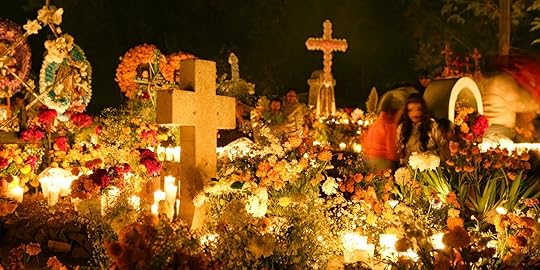 Latin American Day of the Dead
Latin American Day of the Dead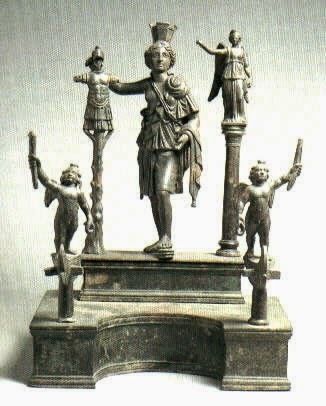
Roman Lemuria
The theological basis for the feast is the doctrine that the souls which, on departing from the body, are not perfectly cleansed from venial sins, or have not fully atoned for past transgressions, are debarred from the Beatific Vision, and that the faithful on earth can help them by prayers, almsdeeds and especially by the sacrifice of the Mass.
 Beatific Vision
Beatific Vision
Published on November 02, 2014 05:00
History Trivia - Thomas Becket, the Archbishop of Canterbury, flees Britain
November 2
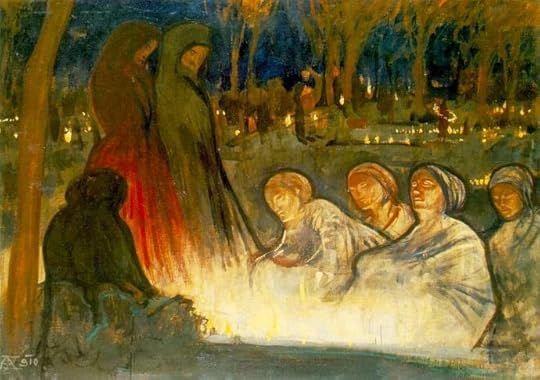
All Souls’ Day.
1164 Thomas Becket, the Archbishop of Canterbury, left Britain because of a quarrel with King Henry II. He fled to Flanders and stayed away from England for 6 years.

1093 Malcolm III MacDuncan, King of Scots, was killed while laying siege to Alnwick in an invasion of England. He was succeeded by his brother Donald Bane.

1541 Henry VIII was informed that Katherine Howard was involved in two affairs before their marriage.

1570 A tidal wave in the North Sea destroyed the sea walls from Holland to Jutland. More than 1,000 people were killed.


All Souls’ Day.

1164 Thomas Becket, the Archbishop of Canterbury, left Britain because of a quarrel with King Henry II. He fled to Flanders and stayed away from England for 6 years.

1093 Malcolm III MacDuncan, King of Scots, was killed while laying siege to Alnwick in an invasion of England. He was succeeded by his brother Donald Bane.

1541 Henry VIII was informed that Katherine Howard was involved in two affairs before their marriage.

1570 A tidal wave in the North Sea destroyed the sea walls from Holland to Jutland. More than 1,000 people were killed.

Published on November 02, 2014 04:56
November 1, 2014
Historical Novels Society review of The Liverpool Connection by Elisabeth Marrion
The Liverpool ConnectionBy Elisabeth Marrion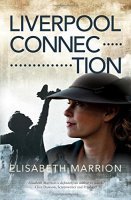 Find & buy onThe Liverpool Connection by Elisabeth Marrion is part two of the author’s trilogy that fictionalises her family history. This time the focus is on a young woman from Ireland who settles in Liverpool in 1926. The book spans twenty years of British and European history, with the emphasis on the home front. Having read the first part, My Dance with Rommel, I am pleased to say that this book can be read on its own and only makes minor but welcome connections to the first book.
Find & buy onThe Liverpool Connection by Elisabeth Marrion is part two of the author’s trilogy that fictionalises her family history. This time the focus is on a young woman from Ireland who settles in Liverpool in 1926. The book spans twenty years of British and European history, with the emphasis on the home front. Having read the first part, My Dance with Rommel, I am pleased to say that this book can be read on its own and only makes minor but welcome connections to the first book.
The author’s talent lies in the details, the description and portrayal of the times and ‘regular’ life before and during WW2. I have read my share of novels about this period of history but was amazed at how much I could take away from the book regarding everyday life and personal perception of the conflict; e.g. the mixed emotions of the Irish volunteers in the British Army. The group of characters are well drawn and thankfully do not resort to the stereotypes that writing about the era so often falls prey to.
The main events of the war are, of course, well known but this book gives several good examples of the multitude of individual journeys throughout these turbulent times.
The narrative structure surprised me at first, as it gave away some dramatic details from 1946 and then jumps backwards in time to Annie’s journey to England; however, this decision pays off since it frees the reader and allows closer and more focused attention on the day-to-day lives. A well-written, competent and fascinating novel.
Historical Novels Society
Purchase Ms. Marrion's book at:
Amazon US
Amazon UK

 Find & buy onThe Liverpool Connection by Elisabeth Marrion is part two of the author’s trilogy that fictionalises her family history. This time the focus is on a young woman from Ireland who settles in Liverpool in 1926. The book spans twenty years of British and European history, with the emphasis on the home front. Having read the first part, My Dance with Rommel, I am pleased to say that this book can be read on its own and only makes minor but welcome connections to the first book.
Find & buy onThe Liverpool Connection by Elisabeth Marrion is part two of the author’s trilogy that fictionalises her family history. This time the focus is on a young woman from Ireland who settles in Liverpool in 1926. The book spans twenty years of British and European history, with the emphasis on the home front. Having read the first part, My Dance with Rommel, I am pleased to say that this book can be read on its own and only makes minor but welcome connections to the first book.The author’s talent lies in the details, the description and portrayal of the times and ‘regular’ life before and during WW2. I have read my share of novels about this period of history but was amazed at how much I could take away from the book regarding everyday life and personal perception of the conflict; e.g. the mixed emotions of the Irish volunteers in the British Army. The group of characters are well drawn and thankfully do not resort to the stereotypes that writing about the era so often falls prey to.
The main events of the war are, of course, well known but this book gives several good examples of the multitude of individual journeys throughout these turbulent times.
The narrative structure surprised me at first, as it gave away some dramatic details from 1946 and then jumps backwards in time to Annie’s journey to England; however, this decision pays off since it frees the reader and allows closer and more focused attention on the day-to-day lives. A well-written, competent and fascinating novel.
Historical Novels Society
Purchase Ms. Marrion's book at:
Amazon US
Amazon UK

Published on November 01, 2014 15:38
History Trivia - Vikings seize control of Eboracum (York)
November 1

All Saints Day.

193 Pertinax became emperor of Rome whose reign lasted three months. He was known as the first emperor of the tumultuous Year of the Five Emperors. He tried to restore discipline in the Praetorian Guards who rebelled and killed him.

866 the Vikings seized control of Eboracum (York), the first major city to fall in their conquest of England.
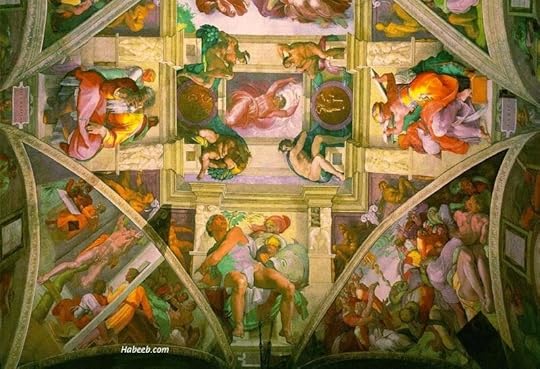
1512 Michelangelo's paintings on the ceiling of Sistine Chapel was first exhibited.

1570 Netherlands was hit by a flood disaster and thousands were killed.

1604 William Shakespeare's tragedy "Othello" was first presented.

1611 Shakespeare's romantic comedy "Tempest" was first presented.


All Saints Day.

193 Pertinax became emperor of Rome whose reign lasted three months. He was known as the first emperor of the tumultuous Year of the Five Emperors. He tried to restore discipline in the Praetorian Guards who rebelled and killed him.

866 the Vikings seized control of Eboracum (York), the first major city to fall in their conquest of England.

1512 Michelangelo's paintings on the ceiling of Sistine Chapel was first exhibited.

1570 Netherlands was hit by a flood disaster and thousands were killed.

1604 William Shakespeare's tragedy "Othello" was first presented.

1611 Shakespeare's romantic comedy "Tempest" was first presented.

Published on November 01, 2014 06:10
October 31, 2014
Great Pumpkin! 9 Fun Facts About the Halloween Gourd
by Tia Ghose

A giant pumpkin. The world record for the heaviest pumpkin was bested in 2013 when Tim Mathison brought his 2,032 pound (921.7 kg) gargantuan gourd to a weigh-off in Napa, California.
Credit: csterken
Autumn is a time for leaf peeping, jack-o'-lanterns and pumpkin pie. The bright orange globes are the quintessential symbols of the season, and spooky jack-o'-lanterns have become a staple of Halloween celebrations everywhere. But long before pumpkin spice lattes became the fall favorite at coffee shops, the fleshy gourd was a symbol of American family farms and a bountiful harvest. From their ancient roots to the biggest pumpkin ever grown, here are nine crazy facts about pumpkins.
1. Ancient plant
Pumpkins are perhaps the oldest domesticated plants on Earth, with archaeological and botanical evidence suggesting that people cultivated pumpkins as far back as 10,000 B.C., said Cindy Ott, an American studies professor at Saint Louis University in Missouri, and the author of "Pumpkin: The Curious History of an American Icon," (University of Washington Press, 2012). The first cultivated pumpkins, which were small, hard gourds that bear little resemblance to the fleshy orange giants of today, likely originated in the highlands of Oaxaca in Mexico, Ott said. [In Images: Peculiar Halloween Pumpkins]
2. Same plant, different name
The scientific name for pumpkins is Cucurbita pepo, with "pepo" meaning "to ripen in the sun." Though Americans consider pumpkins, squash and zucchini to be different foods, they are in fact all the same genus and species, and can be bred with one another. The Europeans who first saw the strange fruits thought they looked a lot like melons, so they called them "pompions," which is French for melon, Ott said.
3. Survival fruit
When the British colonists arrived in North America, they quickly learned to rely on the pumpkin as a survival food because European staples weren't readily available. Pumpkin could be substituted for wheat and barley in beer and was a fast-growing and hardy crop, Ott said.
4. First recipe
Though Thanksgiving is now synonymous with pumpkin pie, the original colonists considered pumpkin more of a savory ingredient, and it's not clear they even ate it on Thanksgiving Day. Most preparations used pumpkin, in addition to corn, in meat stews, Ott said. The first mention of pumpkin pie seems to have been a recipe for "pumpkin pudding baked in a crust," which appeared in the first American cookbook, "American Cookery," published by Amelia Simmons in 1796, Ott said.
5. Farm feed
The pumpkin was never considered a particularly luxurious food, and by the 19th century, when European foods became more readily available, the pumpkin was mainly known as a cheap substitute food or as feed for livestock, Ott said. The only people who grew them were small family farmers, and few people ate pumpkins.
"It was considered food of last resort and food of desperate times," Ott said.
6. Sentimental food
Around the 19th century, when most Americans had stopped eating pumpkins, the squash became associated with nostalgic and romantic images of small American family farms, Ott said. Pumpkins began cropping up in paintings of rustic farms, people wrote sappy odes to the orange fruit and it became an even stronger symbol of the fall harvest and bounty, Ott said.
7. Jack-o'-lanterns
Though the image of a grinning orange face may seem to be the epitome of Halloween now, the pumpkin only recently took up the mantle of jack-o'-lantern. Halloween has its roots in the Celtic holiday of Samhain, when the spirits of the dead walk the Earth for a night and people make lanterns out of turnips to scare the evil spirits away. [10 Ghost Stories That Will Haunt You for Life]
But when Irish immigrants came to the United States, pumpkins as the symbol of small American farms merged with the spooky Halloween tradition. It's not clear when the jack-o'-lantern practice first emerged, but by 1867, an article in the magazine Harper's Weekly shows a spooky image of two boys carving a "pumpkin effigy," the first image of a jack-o'-lantern in its modern-day form.
8. Pie market
The vast majority of pumpkin in the United States is produced and consumed in the fall, and one company, Libby's, produces almost all of the canned pumpkin in the country, Ott said. Because it doesn't make economic sense to ship pumpkins cross-country, most of these pie pumpkins — which, from the outside, look like cantaloupes — are grown in Illinois near the Libby's canning factory, Ott said.
9. Giant pumpkin
Though the average pumpkin in the supermarket may weigh about as much as a bowling ball, competitive pumpkin growers have taken the fruits to new extremes. Giant pumpkin enthusiasts trade tips, such as spiking the soil with fish feed, in order to grow pumpkins of truly gargantuan proportions. In 2013 for instance, a California man broke the world record for the largest pumpkin. At 2,032 pounds (921.7 kilograms), the overgrown squash was nearly the size of a small car.
"These giant pumpkin growers say you can almost see and hear the plant grow, because they grow tens of pounds in a day," Ott said.
Live Science


A giant pumpkin. The world record for the heaviest pumpkin was bested in 2013 when Tim Mathison brought his 2,032 pound (921.7 kg) gargantuan gourd to a weigh-off in Napa, California.
Credit: csterken
Autumn is a time for leaf peeping, jack-o'-lanterns and pumpkin pie. The bright orange globes are the quintessential symbols of the season, and spooky jack-o'-lanterns have become a staple of Halloween celebrations everywhere. But long before pumpkin spice lattes became the fall favorite at coffee shops, the fleshy gourd was a symbol of American family farms and a bountiful harvest. From their ancient roots to the biggest pumpkin ever grown, here are nine crazy facts about pumpkins.
1. Ancient plant
Pumpkins are perhaps the oldest domesticated plants on Earth, with archaeological and botanical evidence suggesting that people cultivated pumpkins as far back as 10,000 B.C., said Cindy Ott, an American studies professor at Saint Louis University in Missouri, and the author of "Pumpkin: The Curious History of an American Icon," (University of Washington Press, 2012). The first cultivated pumpkins, which were small, hard gourds that bear little resemblance to the fleshy orange giants of today, likely originated in the highlands of Oaxaca in Mexico, Ott said. [In Images: Peculiar Halloween Pumpkins]
2. Same plant, different name
The scientific name for pumpkins is Cucurbita pepo, with "pepo" meaning "to ripen in the sun." Though Americans consider pumpkins, squash and zucchini to be different foods, they are in fact all the same genus and species, and can be bred with one another. The Europeans who first saw the strange fruits thought they looked a lot like melons, so they called them "pompions," which is French for melon, Ott said.
3. Survival fruit
When the British colonists arrived in North America, they quickly learned to rely on the pumpkin as a survival food because European staples weren't readily available. Pumpkin could be substituted for wheat and barley in beer and was a fast-growing and hardy crop, Ott said.
4. First recipe
Though Thanksgiving is now synonymous with pumpkin pie, the original colonists considered pumpkin more of a savory ingredient, and it's not clear they even ate it on Thanksgiving Day. Most preparations used pumpkin, in addition to corn, in meat stews, Ott said. The first mention of pumpkin pie seems to have been a recipe for "pumpkin pudding baked in a crust," which appeared in the first American cookbook, "American Cookery," published by Amelia Simmons in 1796, Ott said.
5. Farm feed
The pumpkin was never considered a particularly luxurious food, and by the 19th century, when European foods became more readily available, the pumpkin was mainly known as a cheap substitute food or as feed for livestock, Ott said. The only people who grew them were small family farmers, and few people ate pumpkins.
"It was considered food of last resort and food of desperate times," Ott said.
6. Sentimental food
Around the 19th century, when most Americans had stopped eating pumpkins, the squash became associated with nostalgic and romantic images of small American family farms, Ott said. Pumpkins began cropping up in paintings of rustic farms, people wrote sappy odes to the orange fruit and it became an even stronger symbol of the fall harvest and bounty, Ott said.
7. Jack-o'-lanterns
Though the image of a grinning orange face may seem to be the epitome of Halloween now, the pumpkin only recently took up the mantle of jack-o'-lantern. Halloween has its roots in the Celtic holiday of Samhain, when the spirits of the dead walk the Earth for a night and people make lanterns out of turnips to scare the evil spirits away. [10 Ghost Stories That Will Haunt You for Life]
But when Irish immigrants came to the United States, pumpkins as the symbol of small American farms merged with the spooky Halloween tradition. It's not clear when the jack-o'-lantern practice first emerged, but by 1867, an article in the magazine Harper's Weekly shows a spooky image of two boys carving a "pumpkin effigy," the first image of a jack-o'-lantern in its modern-day form.
8. Pie market
The vast majority of pumpkin in the United States is produced and consumed in the fall, and one company, Libby's, produces almost all of the canned pumpkin in the country, Ott said. Because it doesn't make economic sense to ship pumpkins cross-country, most of these pie pumpkins — which, from the outside, look like cantaloupes — are grown in Illinois near the Libby's canning factory, Ott said.
9. Giant pumpkin
Though the average pumpkin in the supermarket may weigh about as much as a bowling ball, competitive pumpkin growers have taken the fruits to new extremes. Giant pumpkin enthusiasts trade tips, such as spiking the soil with fish feed, in order to grow pumpkins of truly gargantuan proportions. In 2013 for instance, a California man broke the world record for the largest pumpkin. At 2,032 pounds (921.7 kilograms), the overgrown squash was nearly the size of a small car.
"These giant pumpkin growers say you can almost see and hear the plant grow, because they grow tens of pounds in a day," Ott said.
Live Science

Published on October 31, 2014 12:02
All Saints' Day - November 1
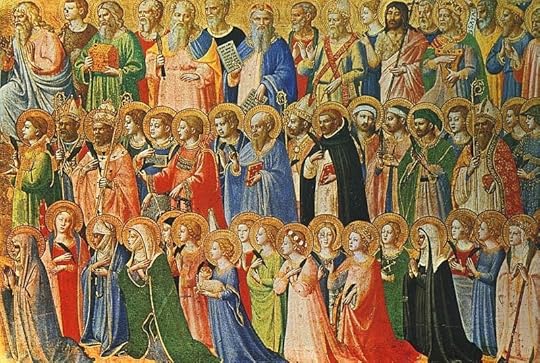
November 1 All Saints' Day
The origins of the holiday commemorating all the saints of the church are obscure, but by the mid-eighth century, November 1st was the day to honor all known and unknown saints in the Catholic Church.
In 837, its general observance was ordered by Pope Gregory IV The date may have been selected for its coincidence with pagan observations of the harvest, including the ancient Celtic festival of Samhain and the ancient Finnish celebration of Kekri.
 Celtic festival of Samhain
Celtic festival of Samhain
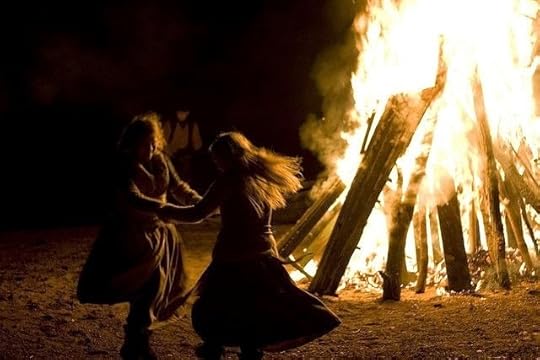 Finnish celebration of Kekri
Finnish celebration of Kekri

Published on October 31, 2014 11:30



